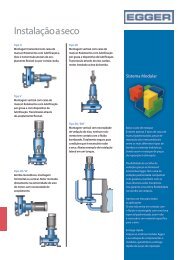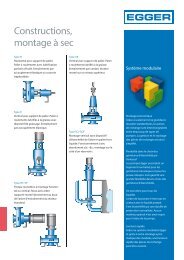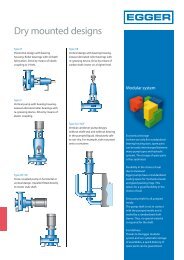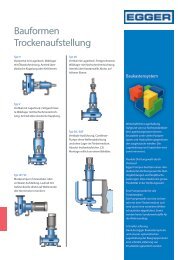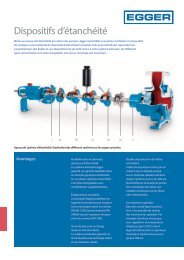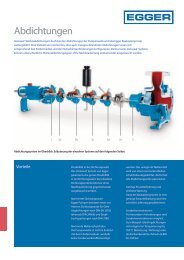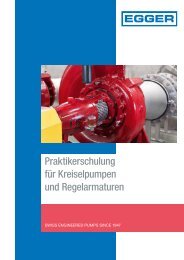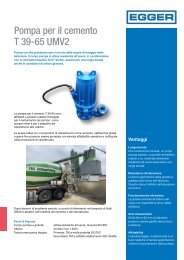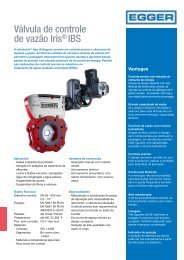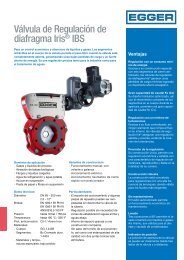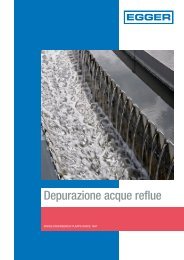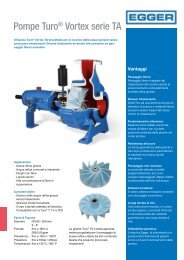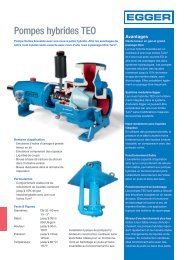Varioseal® shaft seals - Egger
Egger’s modular concept even gets extended to the design of the pump shaft seal. A variety of standard and customised seals can be configured, depending on the fluids being transported and the safety requirements. Thanks to our Varioseal® system, various shaft sealing units can be interchanged without remachining.
Egger’s modular concept even gets extended to the design of the pump shaft seal. A variety of standard and customised seals can be configured, depending on the fluids being transported and the safety requirements. Thanks to our Varioseal® system, various shaft sealing units can be interchanged without remachining.
- TAGS
- egger pumps
- eurodyn®
- liquid barrier
- quenching connection
- cartridge mechanical seal
- back to back arrangement
- pressureless sealing liquid
- tandem arrangement
- double mechanical seal
- external flushing liquid
- single mechanical seal
- classic stuffing box
- gland packing rings
- simple maintenance
- reduced spare parts stock
- modular concept
- varioseal® shaft seals
- friction and wear free
- permanent lubrication
- hydrodynamic sealing
Create successful ePaper yourself
Turn your PDF publications into a flip-book with our unique Google optimized e-Paper software.
Seals<br />
Varioseal ® <strong>shaft</strong> <strong>seals</strong>: <strong>Egger</strong>’s modular concept even gets extended to the design of the pump <strong>shaft</strong> seal.<br />
A variety of standard and customised <strong>seals</strong> can be configured, depending on the fluids being transported and<br />
the safety requirements. Thanks to our Varioseal ® system, various <strong>shaft</strong> sealing units can be interchanged<br />
without remachining.<br />
1 2a 2b 2c 2d 2e 3<br />
An overview of the Varioseal system: Explanation of the individual systems on the following pages.<br />
Advantages<br />
Flexibility in the choice of seal<br />
The <strong>Egger</strong> Varioseal ® system<br />
guarantees a high level of flexibility<br />
in the selection of the seal.<br />
Different seal systems can be<br />
interchanged without remachining.<br />
Standard sealing chamber<br />
<strong>Egger</strong> pumps have a standardised<br />
sealing chamber for mechanical<br />
<strong>seals</strong> in accordance with DIN EN<br />
12756 (formerly DIN 24960) and for<br />
gland packing in accordance with<br />
DIN 3780.<br />
Standard <strong>shaft</strong> sleeve<br />
The pump <strong>shaft</strong> is not in contact<br />
with the pumped medium and hence<br />
no special material is required. The<br />
non-alloy steel <strong>shaft</strong> is sealed by a<br />
standard <strong>shaft</strong> sleeve which is<br />
adapted to almost all types of <strong>seals</strong>.<br />
Reduced spare parts stock and<br />
simple maintenance<br />
A reduced spare parts stock and a<br />
fast delivery are guaranteed, thanks<br />
to the modular system.<br />
Special designs<br />
Special designs are available for<br />
specific requirements. For example:<br />
mechanical <strong>seals</strong> with integrated<br />
temperature control up to 350 °C<br />
(heating / cooling) or triple high<br />
pressure mechanical <strong>seals</strong> up to<br />
100 bar.
1. Gland packing rings<br />
The classic stuffing box with packing rings is still used today in certain<br />
branches of the industry.<br />
Its robustness and simplicity are<br />
appreciated, as well as the possibility<br />
to schedule the maintenance time in<br />
advance, as a failure is generally<br />
indicated over a longer period. Usually<br />
a permanent external sealing liquid is<br />
necessary to ensure a clean liquid film<br />
between the packing rings and the<br />
<strong>shaft</strong> sleeve for cooling and lubrication.<br />
A continuously visible small drip<br />
leak is a good sign that the outer gland<br />
packing ring is adequately lubricated<br />
and cooled on the atmosphere side<br />
and that the seal operates properly.<br />
However the presence of leakage<br />
means that the use of packing rings<br />
is getting less popular, due to the<br />
increasingly stricter environmental<br />
regulations.<br />
2. Mechanical <strong>seals</strong><br />
A thin lubricant film between the seal faces is required for the safe function<br />
of a mechanical seal. For this reason a certain leakage is always present<br />
when using mechanical <strong>seals</strong>. The amount of leakage depends on the size of<br />
the seal, the differential pressure, the rotation speed and the properties<br />
of the medium. It reaches the atmosphere as steam or drip leakage in very<br />
small quantities.<br />
2a. Single mechanical seal<br />
The single mechanical seal uses a<br />
simple face pair (rotating face and<br />
static face) to seal the hydraulic part<br />
from the atmosphere. Generally, a<br />
mechanical seal failure leads to abrupt<br />
leakage on the atmospheric side, thus<br />
the conveyed liquid escapes to the<br />
environment without hindrance. When<br />
the type is selected correctly, the<br />
single mechanical seal is a reliable and<br />
cost-effective seal version.<br />
2b. Single mechanical seal with<br />
external flushing liquid<br />
For this design, flushing liquid is<br />
permanently fed into the sealing space<br />
via a flushing connection according to<br />
API-Plan 12/32 and thus into the pump<br />
housing. An external liquid or pumped<br />
medium extracted from the pressure<br />
side (and previously cleaned as required)<br />
can be used for flushing. To maintain<br />
low flushing quantities, a throttle bush<br />
(see detail) is provided to keep the<br />
solids away from the mechanical seal<br />
by means of a narrow gap. This is a<br />
cost-effective seal version for pumped<br />
media containing solids when a<br />
flushing liquid can be used.
2c. Double mechanical seal in<br />
tandem arrangement<br />
Design with pressureless internal<br />
sealing liquid. Unlike the single design,<br />
double mechanical <strong>seals</strong> prevent any<br />
leakage to the atmosphere for a certain<br />
period, in the event that the primary<br />
seal breaks during operation.<br />
Two single mechanical <strong>seals</strong> are positioned<br />
in series as a double seal for the<br />
tandem version. The sealing space is<br />
lubricated with a pressureless internal<br />
sealing liquid (quench). The tandem<br />
version also guarantees protection<br />
from a brief dry run and is versatile as<br />
it can be used for media up to 80 °C.<br />
2d. Double mechanical seal in<br />
back-to-back arrangement<br />
Design with pressurized sealing liquid.<br />
For the back-to-back arrangement, two<br />
single mechanical <strong>seals</strong> are positioned<br />
opposite each other (back-to-back).<br />
The chamber between the two <strong>seals</strong><br />
is filled with a sealing liquid, which pressure<br />
must always be higher than the<br />
discharge pressure. This is generally<br />
ensured and monitored by an external<br />
sealing supply system (API-Plan 53/54).<br />
The back-to-back version provides a<br />
high level of safety against the leakage<br />
of dangerous liquids but only has<br />
limited usage for media containing<br />
solids or cystallizing fluids. It is preferably<br />
used for aggressive media, as no<br />
metallic components of the mechanical<br />
seal can come into contact with the<br />
pumped medium. The sealing liquid can<br />
optionally be circulated by means of<br />
a pumping screw, that is integrated in<br />
the mechanical seal.<br />
2e. Cartridge mechanical seal<br />
Cartridge mechanical <strong>seals</strong> are assembled<br />
and tested by the mechanical<br />
seal manufacturer. Their installation and<br />
replacement are therefore very easy<br />
and assembly errors can almost be<br />
excluded. Cartridge mechanical <strong>seals</strong><br />
are available in different versions<br />
(single, double, with liquid barrier or/<br />
and quenching connection, etc.)<br />
and generally have an integrated <strong>shaft</strong><br />
sleeve. They are either mounted<br />
directly on the <strong>shaft</strong> or alternatively on<br />
an additional <strong>shaft</strong> sleeve.
3. Hydrodynamic <strong>shaft</strong> seal Eurodyn ®<br />
Hydrodynamic <strong>shaft</strong> <strong>seals</strong> collect the fluid behind the impeller and rotate it. As a result, a liquid ring is<br />
created, which <strong>seals</strong> the pump to the atmosphere. The Eurodyn ® hydrodynamic <strong>shaft</strong> seal operates without<br />
friction nor wear and is mainly suited for continuous pump operation. Eurodyn ® <strong>seals</strong> have a long service<br />
life, high system availability, low maintenance and are very reliable and safe. They are also suitable for media<br />
with a high solid concentration and viscosity.<br />
Similar to the gland packing rings, the<br />
hydrodynamic <strong>shaft</strong> seal is a seal system<br />
that has been known and used<br />
for a very long time. It features contactfree<br />
operation and is practically maintenance-free<br />
depending on the pumped<br />
medium. At least one repeller is installed<br />
behind the impeller and generates<br />
enough counter-pressure by means<br />
of a liquid ring to withstand the internal<br />
pump pressure. As a result a leakfree<br />
seal to the atmosphere is guaranteed<br />
as long as the pump is in operation.<br />
Hydrodynamic <strong>seals</strong> often require<br />
special pump designs – one reason<br />
why this type of seal is not widely used.<br />
to keep solids away from the static seal.<br />
Eurodyn ® has been successfully used<br />
for continuous as well as intermediate<br />
operation especially for vertical designs<br />
with clean fluids, media containing<br />
solids or viscous liquids.<br />
A special feature of the <strong>Egger</strong> Eurodyn ®<br />
hydrodynamic seal is its seamless<br />
integration within the Varioseal ® system.<br />
No special designs are required for the<br />
pump. It also has four repellers and is<br />
available as a completely mounted unit<br />
with its own <strong>shaft</strong> sleeve. Like a cartridge,<br />
Eurodyn ® is therefore very easy<br />
to assemble. At standstill, a seal ring<br />
withstands the static pressure in the<br />
Eurodyn ® housing. The static seal of<br />
the Eurodyn ® can be adapted to different<br />
media requirements and applications.<br />
In addition to the classic Elring<br />
seal, we offer a friction free HTS static<br />
ring as well as a special Prelon ring on<br />
a hardened <strong>shaft</strong> sleeve. Eurodyn ® is<br />
also available with a grease chamber<br />
and a permanent lubrication for applications<br />
with a high level of solids. If<br />
greasing is not allowed, Eurodyn ® can<br />
be provided with permanent flushing<br />
1300.en - 02.2017<br />
Headquarter<br />
Emile <strong>Egger</strong> & Cie SA<br />
Route de Neuchâtel 36<br />
2088 Cressier NE (Switzerland)<br />
Phone +41 (0)32 758 71 11<br />
Fax +41 (0)32 757 22 90<br />
info@eggerpumps.com<br />
Offices and representatives countries<br />
Austria<br />
Belgium<br />
China<br />
France<br />
Germany<br />
Great Britain<br />
India<br />
Italy<br />
Netherland<br />
Spain<br />
Sweden<br />
Switzerland<br />
USA<br />
Further information can be found on:<br />
www.eggerpumps.com




